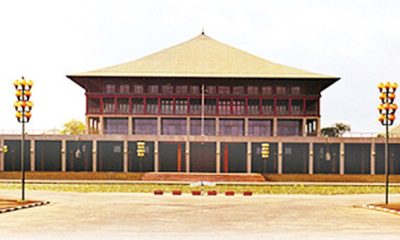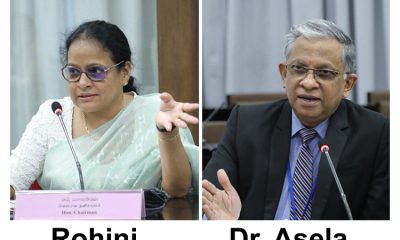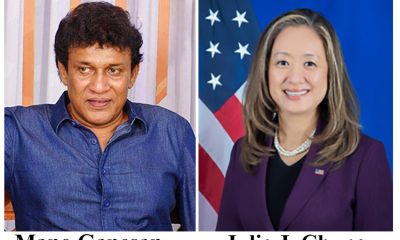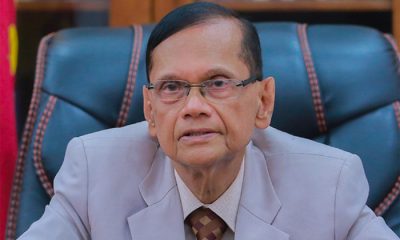Features
Visa Debacle: Fixing what ain’t broken

by Dr Sirimewan Dharmaratne,
former Senior Analyst, HMRC, UK
There is a famous saying ‘If it ain’t broke, don’t fix it. Sri Lanka seems to be the exception to this rule. This is no more laid bare than the current debacle with tourist visas. Most countries that want tourist dollars have visa free entry or a minimal fee. A visa is a means for controlling access and a fee act as a further deterrent. It is a form of a user fee that is designed to restrict entry. Therefore, if you want tourists to come to your country and spend money, simple economics says not to charge an entry fee.
Reciprocal Requirements
The justification seems to be centred around the fact that Lankans pay much higher fees to this company when they travel compared to what visitors pay to come to Sri Lanka. This justification alone typifies why Sri Lanka is where it is now. The underlying issues here is not what Sri Lankans have to pay when they travel abroad but what tourists have to pay when they come to Sri Lanka. This is what those who are actually making a living from the tourism is concerned about. Most developed countries have stringent visa requirements for citizens of less developed countries for obvious reasons. But those countries do not have reciprocal requirements. This is not because they don’t have pride, but because they need the money that tourism brings in. It makes good business sense.
They make more money by allowing well-off tourists to come freely and spend rather than by selling visas.
Elated by the recent surge in tourist arrivals, in the eyes of the government, Sri Lanka is now a ‘cannot do without’ destination. Therefore, the first response is to increase the price of everything, starting with a visa fee and let others have a piece of the pie as well. Having this overassessment about the value of the country has led to various forms of rip-offs, some of which have been widely circulated in social media. Further, one has only to check hotel rates and other accommodation to realise how the rates have gone up astronomically. Increase of visa fee appears to be following the same misguided thinking. The truth, however, is that Sri Lanka is considered a ‘cheap’ destination for an ‘exotic’ holiday. It does not particularly standout in any aspect, such as beaches, nature, wildlife or food compared to other similar destinations. As Sri Lankans, we all have a visceral value of the country, but in the eyes of tourists, it is one of the many destinations that they can spend their money on and not a place to be visited at any cost.
Demand for Travel
Access costs determined the demand for a destination. When there are competing destinations in terms of characteristics, a savvy, erudite traveller will naturally select a destination that has lower access cost. While there is some flexibility in certain access costs, such as airfares, visa costs are regarded as a waste that does not add anything to the value of a trip. Most Western tourists look at it in disdain because they believe, rightly or wrongly, developing nations should be facilitating their patronage and not restrict it. Therefore, the issue is not what Sri Lankans have to pay when they travel overseas, but what tourists have to pay when they come to Sri Lanka compared to other South Asian destinations.
Sri Lanka had a somewhat high US$50 visa, which most visitors acquiesced. According to SLTDA’s own departure survey, most visitors stay 21 days or less with most frequent length-of-stay being 14 or 21 days. Therefore, it is likely that in excess of 95% of the visitors would have obtained this visa. This option that was mysteriously excluded, appears to have been reinstated. However, what in fact is the correct fee is sketchy.
If the proposed service fees are added, then the actual cost to the visitor could be as high as $75, which is a 50% increase. This is where knowledge of some basic economics would have been helpful. If you raise the price of goods or service without a discernible increase in quality, the demand will go down.
May it be for eggs, bread, fuel or visas, this is one of the basic economic principles that actually work. On the other hand, there is evidence that while the visa fee is US$50, only US$40 is paid to the government with the remaining US$10 is paid to the company as a ‘service’ fee. If this is the case, then it is absolute madness. While the visitors don’t care how the money is divided, it is imbecilic to hand over US$10 from each visitor for a service that was done for free just a month ago. The thinking and reasoning behind this defeat any form of rationality and can only be attributed to a perfidious, self-serving motive.
Uniqueness and elasticity
How much the visits would go down depends on the amount of increase and availability of substitutes. These two together show how elastic the demand would be.
This is where Sri Lanka has no particular advantage compared to other countries in the region. There are plenty of close substitute destinations if tourists want to visit South East Asia, which offer visa free arrival or a minimal visa fee. Apart from that, for European tourists, a whole new market has opened up in Eastern Europe, Andalucía, Türkiye and in the former Soviet republics, where holidays are ridiculously cheap. Majority of these countries do not have visa requirements for Western European tourists, which is their target market.
Sri Lanka also does not have any ‘must see’ places, such as Machu Picchu, Great Wall or Angkor Wat. There is no compelling reason for a visitor to specifically select Sri Lanka that would justify the additional access cost. What is on offer is fairly prosaic, and comparable to many other countries that offer similar experiences.
The bottom line is despite the euphoria surrounding the new found tourism goldmine, Sri Lanka is easily substitutable and therefore the demand is likely to be very elastic. If this nonsensical visa fee continues to exist, then a significant reduction in visitation can be expected, especially those with families. The loss will not be to the tourists but to Sri Lanka.
Logic of Outsourcing
With Sri Lanka being a popular outsourcing destination, it is hard to comprehend that there is no firm that could perform this task. In fact, a local entity seems to have manage well up to 16 April, and through the peak of arrivals during the winter months. Why their service no longer suffices is a mystery. Further, according to reports, Sri Lankan IT professionals could have done and were doing the work for a fraction of the cost. What is the compelling reason to change the status quo? There have been no reports of major infringements or capacity issues. So why fix something that was not broken?
Length of Contract
This is another aspect of this arrangement that does not make any sense. Why get into a 16-year contract when the world of IT and AI is fast changing? There are already unmanned immigration counters in many airports. Most documents and applications are now machine processed. It is predicted that most back-office work will become redundant in the near future. This company need not make huge investment on infrastructure to take this additional work on for Sri Lanka. Such a large company should be able to easily absorb this work without significant additional investment. Therefore, there is no reason to ask or agree to a contract for the next 16 years! This is an egregious decision on the part of the government, or is there some other in-win agreement that does not benefit the country?
Money Trail
Another dubious aspect of this contract is how the visa revenue is transferred to Sri Lanka. Apparently, when visas were processed locally, the daily take was sent to the Treasury at the end of each day. With the new arrangement, it is understood that the daily revenue is sent to a Dubai account of the company and transferred to Sri Lanka two days later, sans service charges. Based on an average of 5,000 daily visitors and a US$50 visa fee, this means maintaining an account with a minimum daily balance of US$250,000 in an overseas bank using Sri Lankan visa fees, but that does not belong to Sri Lanka. This guaranteed money could be used for various reasons, apart from the interest that could accrue on a daily basis, such as for overnight lending. The bottom line is that other than the undeserved service fee, the company is placed to generate more income from the financial arrangement and contract that Sri Lanka has seemingly sleepwalked into.
Security
The justification that it is a global company which processes visas in many countries is irrelevant. In any country, by law, one has to first look for local contractors before looking overseas. There is no evidence this procedure has been followed. But the more compelling issue is national security. Although, it is now said that foreign nationals would not man visa counters, they will have access to vast amounts of information and data that could be used for the benefit of a foreign nation. Although visa issuance may be done by Sri Lankans, back-office staff could be selectively biased in forwarding applications. This could create problems for the Sri Lankan governments from friendly nations if they see a pattern of bias. These concerns have been already raised by countries that are crucial for Sri Lankan foreign relations.
Prognosis
This change does not pass any logic that could justify such a monumental change. It appears to have been done in an ad hoc manner without doing a proper economic analysis or any other analysis relating to viability, security or economic development. There will definitely be a drop in visitations as there won’t be free entry for citizens of any country, even those who enjoyed that benefit earlier. What is most likely to suffer is family visits, because a potential increase in access cost of $300 to an average family of four would be a significant shock.
If the process is more convoluted, which requires submitting further documentation other than just passport information, it will be a further deterrent. All this will have a negative impact on the visitation rates that are now envisaged by those who are actually keeping Sri Lanka tourism going. There will be a corresponding impact on the local economy.
Currently Sri Lanka only enjoys a measly 15% repeat visitors, most of whom may even not be bone fide tourists. This is compared to nearly 40% repeat visitors in a destination like Barbados, which has no visa requirement for European or North American tourists. How a country, which has absolutely nothing over Sri Lanka has achieved this feat needs to be understood. It is definitely not by making visitors unwelcomed at the port of entry. Sri Lanka needs to rethink where they are going with tourism in the future and not kill the proverbial ‘goose that lays the golden eggs.’
Features
The heart-friendly health minister

by Dr Gotabhya Ranasinghe
Senior Consultant Cardiologist
National Hospital Sri Lanka
When we sought a meeting with Hon Dr. Ramesh Pathirana, Minister of Health, he graciously cleared his busy schedule to accommodate us. Renowned for his attentive listening and deep understanding, Minister Pathirana is dedicated to advancing the health sector. His openness and transparency exemplify the qualities of an exemplary politician and minister.
Dr. Palitha Mahipala, the current Health Secretary, demonstrates both commendable enthusiasm and unwavering support. This combination of attributes makes him a highly compatible colleague for the esteemed Minister of Health.
Our discussion centered on a project that has been in the works for the past 30 years, one that no other minister had managed to advance.
Minister Pathirana, however, recognized the project’s significance and its potential to revolutionize care for heart patients.
The project involves the construction of a state-of-the-art facility at the premises of the National Hospital Colombo. The project’s location within the premises of the National Hospital underscores its importance and relevance to the healthcare infrastructure of the nation.
This facility will include a cardiology building and a tertiary care center, equipped with the latest technology to handle and treat all types of heart-related conditions and surgeries.
Securing funding was a major milestone for this initiative. Minister Pathirana successfully obtained approval for a $40 billion loan from the Asian Development Bank. With the funding in place, the foundation stone is scheduled to be laid in September this year, and construction will begin in January 2025.
This project guarantees a consistent and uninterrupted supply of stents and related medications for heart patients. As a result, patients will have timely access to essential medical supplies during their treatment and recovery. By securing these critical resources, the project aims to enhance patient outcomes, minimize treatment delays, and maintain the highest standards of cardiac care.
Upon its fruition, this monumental building will serve as a beacon of hope and healing, symbolizing the unwavering dedication to improving patient outcomes and fostering a healthier society.We anticipate a future marked by significant progress and positive outcomes in Sri Lanka’s cardiovascular treatment landscape within the foreseeable timeframe.
Features
A LOVING TRIBUTE TO JESUIT FR. ALOYSIUS PIERIS ON HIS 90th BIRTHDAY

by Fr. Emmanuel Fernando, OMI
Jesuit Fr. Aloysius Pieris (affectionately called Fr. Aloy) celebrated his 90th birthday on April 9, 2024 and I, as the editor of our Oblate Journal, THE MISSIONARY OBLATE had gone to press by that time. Immediately I decided to publish an article, appreciating the untiring selfless services he continues to offer for inter-Faith dialogue, the renewal of the Catholic Church, his concern for the poor and the suffering Sri Lankan masses and to me, the present writer.
It was in 1988, when I was appointed Director of the Oblate Scholastics at Ampitiya by the then Oblate Provincial Fr. Anselm Silva, that I came to know Fr. Aloy more closely. Knowing well his expertise in matters spiritual, theological, Indological and pastoral, and with the collaborative spirit of my companion-formators, our Oblate Scholastics were sent to Tulana, the Research and Encounter Centre, Kelaniya, of which he is the Founder-Director, for ‘exposure-programmes’ on matters spiritual, biblical, theological and pastoral. Some of these dimensions according to my view and that of my companion-formators, were not available at the National Seminary, Ampitiya.
Ever since that time, our Oblate formators/ accompaniers at the Oblate Scholasticate, Ampitiya , have continued to send our Oblate Scholastics to Tulana Centre for deepening their insights and convictions regarding matters needed to serve the people in today’s context. Fr. Aloy also had tried very enthusiastically with the Oblate team headed by Frs. Oswald Firth and Clement Waidyasekara to begin a Theologate, directed by the Religious Congregations in Sri Lanka, for the contextual formation/ accompaniment of their members. It should very well be a desired goal of the Leaders / Provincials of the Religious Congregations.
Besides being a formator/accompanier at the Oblate Scholasticate, I was entrusted also with the task of editing and publishing our Oblate journal, ‘The Missionary Oblate’. To maintain the quality of the journal I continue to depend on Fr. Aloy for his thought-provoking and stimulating articles on Biblical Spirituality, Biblical Theology and Ecclesiology. I am very grateful to him for his generous assistance. Of late, his writings on renewal of the Church, initiated by Pope St. John XX111 and continued by Pope Francis through the Synodal path, published in our Oblate journal, enable our readers to focus their attention also on the needed renewal in the Catholic Church in Sri Lanka. Fr. Aloy appreciated very much the Synodal path adopted by the Jesuit Pope Francis for the renewal of the Church, rooted very much on prayerful discernment. In my Religious and presbyteral life, Fr.Aloy continues to be my spiritual animator / guide and ongoing formator / acccompanier.
Fr. Aloysius Pieris, BA Hons (Lond), LPh (SHC, India), STL (PFT, Naples), PhD (SLU/VC), ThD (Tilburg), D.Ltt (KU), has been one of the eminent Asian theologians well recognized internationally and one who has lectured and held visiting chairs in many universities both in the West and in the East. Many members of Religious Congregations from Asian countries have benefited from his lectures and guidance in the East Asian Pastoral Institute (EAPI) in Manila, Philippines. He had been a Theologian consulted by the Federation of Asian Bishops’ Conferences for many years. During his professorship at the Gregorian University in Rome, he was called to be a member of a special group of advisers on other religions consulted by Pope Paul VI.
Fr. Aloy is the author of more than 30 books and well over 500 Research Papers. Some of his books and articles have been translated and published in several countries. Among those books, one can find the following: 1) The Genesis of an Asian Theology of Liberation (An Autobiographical Excursus on the Art of Theologising in Asia, 2) An Asian Theology of Liberation, 3) Providential Timeliness of Vatican 11 (a long-overdue halt to a scandalous millennium, 4) Give Vatican 11 a chance, 5) Leadership in the Church, 6) Relishing our faith in working for justice (Themes for study and discussion), 7) A Message meant mainly, not exclusively for Jesuits (Background information necessary for helping Francis renew the Church), 8) Lent in Lanka (Reflections and Resolutions, 9) Love meets wisdom (A Christian Experience of Buddhism, 10) Fire and Water 11) God’s Reign for God’s poor, 12) Our Unhiddden Agenda (How we Jesuits work, pray and form our men). He is also the Editor of two journals, Vagdevi, Journal of Religious Reflection and Dialogue, New Series.
Fr. Aloy has a BA in Pali and Sanskrit from the University of London and a Ph.D in Buddhist Philosophy from the University of Sri Lankan, Vidyodaya Campus. On Nov. 23, 2019, he was awarded the prestigious honorary Doctorate of Literature (D.Litt) by the Chancellor of the University of Kelaniya, the Most Venerable Welamitiyawe Dharmakirthi Sri Kusala Dhamma Thera.
Fr. Aloy continues to be a promoter of Gospel values and virtues. Justice as a constitutive dimension of love and social concern for the downtrodden masses are very much noted in his life and work. He had very much appreciated the commitment of the late Fr. Joseph (Joe) Fernando, the National Director of the Social and Economic Centre (SEDEC) for the poor.
In Sri Lanka, a few religious Congregations – the Good Shepherd Sisters, the Christian Brothers, the Marist Brothers and the Oblates – have invited him to animate their members especially during their Provincial Congresses, Chapters and International Conferences. The mainline Christian Churches also have sought his advice and followed his seminars. I, for one, regret very much, that the Sri Lankan authorities of the Catholic Church –today’s Hierarchy—- have not sought Fr.
Aloy’s expertise for the renewal of the Catholic Church in Sri Lanka and thus have not benefited from the immense store of wisdom and insight that he can offer to our local Church while the Sri Lankan bishops who governed the Catholic church in the immediate aftermath of the Second Vatican Council (Edmund Fernando OMI, Anthony de Saram, Leo Nanayakkara OSB, Frank Marcus Fernando, Paul Perera,) visited him and consulted him on many matters. Among the Tamil Bishops, Bishop Rayappu Joseph was keeping close contact with him and Bishop J. Deogupillai hosted him and his team visiting him after the horrible Black July massacre of Tamils.
Features
A fairy tale, success or debacle

Sri Lanka-Singapore Free Trade Agreement
By Gomi Senadhira
senadhiragomi@gmail.com
“You might tell fairy tales, but the progress of a country cannot be achieved through such narratives. A country cannot be developed by making false promises. The country moved backward because of the electoral promises made by political parties throughout time. We have witnessed that the ultimate result of this is the country becoming bankrupt. Unfortunately, many segments of the population have not come to realize this yet.” – President Ranil Wickremesinghe, 2024 Budget speech
Any Sri Lankan would agree with the above words of President Wickremesinghe on the false promises our politicians and officials make and the fairy tales they narrate which bankrupted this country. So, to understand this, let’s look at one such fairy tale with lots of false promises; Ranil Wickremesinghe’s greatest achievement in the area of international trade and investment promotion during the Yahapalana period, Sri Lanka-Singapore Free Trade Agreement (SLSFTA).
It is appropriate and timely to do it now as Finance Minister Wickremesinghe has just presented to parliament a bill on the National Policy on Economic Transformation which includes the establishment of an Office for International Trade and the Sri Lanka Institute of Economics and International Trade.
Was SLSFTA a “Cleverly negotiated Free Trade Agreement” as stated by the (former) Minister of Development Strategies and International Trade Malik Samarawickrama during the Parliamentary Debate on the SLSFTA in July 2018, or a colossal blunder covered up with lies, false promises, and fairy tales? After SLSFTA was signed there were a number of fairy tales published on this agreement by the Ministry of Development Strategies and International, Institute of Policy Studies, and others.
However, for this article, I would like to limit my comments to the speech by Minister Samarawickrama during the Parliamentary Debate, and the two most important areas in the agreement which were covered up with lies, fairy tales, and false promises, namely: revenue loss for Sri Lanka and Investment from Singapore. On the other important area, “Waste products dumping” I do not want to comment here as I have written extensively on the issue.
1. The revenue loss
During the Parliamentary Debate in July 2018, Minister Samarawickrama stated “…. let me reiterate that this FTA with Singapore has been very cleverly negotiated by us…. The liberalisation programme under this FTA has been carefully designed to have the least impact on domestic industry and revenue collection. We have included all revenue sensitive items in the negative list of items which will not be subject to removal of tariff. Therefore, 97.8% revenue from Customs duty is protected. Our tariff liberalisation will take place over a period of 12-15 years! In fact, the revenue earned through tariffs on goods imported from Singapore last year was Rs. 35 billion.
The revenue loss for over the next 15 years due to the FTA is only Rs. 733 million– which when annualised, on average, is just Rs. 51 million. That is just 0.14% per year! So anyone who claims the Singapore FTA causes revenue loss to the Government cannot do basic arithmetic! Mr. Speaker, in conclusion, I call on my fellow members of this House – don’t mislead the public with baseless criticism that is not grounded in facts. Don’t look at petty politics and use these issues for your own political survival.”
I was surprised to read the minister’s speech because an article published in January 2018 in “The Straits Times“, based on information released by the Singaporean Negotiators stated, “…. With the FTA, tariff savings for Singapore exports are estimated to hit $10 million annually“.
As the annual tariff savings (that is the revenue loss for Sri Lanka) calculated by the Singaporean Negotiators, Singaporean $ 10 million (Sri Lankan rupees 1,200 million in 2018) was way above the rupees’ 733 million revenue loss for 15 years estimated by the Sri Lankan negotiators, it was clear to any observer that one of the parties to the agreement had not done the basic arithmetic!
Six years later, according to a report published by “The Morning” newspaper, speaking at the Committee on Public Finance (COPF) on 7th May 2024, Mr Samarawickrama’s chief trade negotiator K.J. Weerasinghehad had admitted “…. that forecasted revenue loss for the Government of Sri Lanka through the Singapore FTA is Rs. 450 million in 2023 and Rs. 1.3 billion in 2024.”
If these numbers are correct, as tariff liberalisation under the SLSFTA has just started, we will pass Rs 2 billion very soon. Then, the question is how Sri Lanka’s trade negotiators made such a colossal blunder. Didn’t they do their basic arithmetic? If they didn’t know how to do basic arithmetic they should have at least done their basic readings. For example, the headline of the article published in The Straits Times in January 2018 was “Singapore, Sri Lanka sign FTA, annual savings of $10m expected”.
Anyway, as Sri Lanka’s chief negotiator reiterated at the COPF meeting that “…. since 99% of the tariffs in Singapore have zero rates of duty, Sri Lanka has agreed on 80% tariff liberalisation over a period of 15 years while expecting Singapore investments to address the imbalance in trade,” let’s turn towards investment.
Investment from Singapore
In July 2018, speaking during the Parliamentary Debate on the FTA this is what Minister Malik Samarawickrama stated on investment from Singapore, “Already, thanks to this FTA, in just the past two-and-a-half months since the agreement came into effect we have received a proposal from Singapore for investment amounting to $ 14.8 billion in an oil refinery for export of petroleum products. In addition, we have proposals for a steel manufacturing plant for exports ($ 1 billion investment), flour milling plant ($ 50 million), sugar refinery ($ 200 million). This adds up to more than $ 16.05 billion in the pipeline on these projects alone.
And all of these projects will create thousands of more jobs for our people. In principle approval has already been granted by the BOI and the investors are awaiting the release of land the environmental approvals to commence the project.
I request the Opposition and those with vested interests to change their narrow-minded thinking and join us to develop our country. We must always look at what is best for the whole community, not just the few who may oppose. We owe it to our people to courageously take decisions that will change their lives for the better.”
According to the media report I quoted earlier, speaking at the Committee on Public Finance (COPF) Chief Negotiator Weerasinghe has admitted that Sri Lanka was not happy with overall Singapore investments that have come in the past few years in return for the trade liberalisation under the Singapore-Sri Lanka Free Trade Agreement. He has added that between 2021 and 2023 the total investment from Singapore had been around $162 million!
What happened to those projects worth $16 billion negotiated, thanks to the SLSFTA, in just the two-and-a-half months after the agreement came into effect and approved by the BOI? I do not know about the steel manufacturing plant for exports ($ 1 billion investment), flour milling plant ($ 50 million) and sugar refinery ($ 200 million).
However, story of the multibillion-dollar investment in the Petroleum Refinery unfolded in a manner that would qualify it as the best fairy tale with false promises presented by our politicians and the officials, prior to 2019 elections.
Though many Sri Lankans got to know, through the media which repeatedly highlighted a plethora of issues surrounding the project and the questionable credentials of the Singaporean investor, the construction work on the Mirrijiwela Oil Refinery along with the cement factory began on the24th of March 2019 with a bang and Minister Ranil Wickremesinghe and his ministers along with the foreign and local dignitaries laid the foundation stones.
That was few months before the 2019 Presidential elections. Inaugurating the construction work Prime Minister Ranil Wickremesinghe said the projects will create thousands of job opportunities in the area and surrounding districts.
The oil refinery, which was to be built over 200 acres of land, with the capacity to refine 200,000 barrels of crude oil per day, was to generate US$7 billion of exports and create 1,500 direct and 3,000 indirect jobs. The construction of the refinery was to be completed in 44 months. Four years later, in August 2023 the Cabinet of Ministers approved the proposal presented by President Ranil Wickremesinghe to cancel the agreement with the investors of the refinery as the project has not been implemented! Can they explain to the country how much money was wasted to produce that fairy tale?
It is obvious that the President, ministers, and officials had made huge blunders and had deliberately misled the public and the parliament on the revenue loss and potential investment from SLSFTA with fairy tales and false promises.
As the president himself said, a country cannot be developed by making false promises or with fairy tales and these false promises and fairy tales had bankrupted the country. “Unfortunately, many segments of the population have not come to realize this yet”.
(The writer, a specialist and an activist on trade and development issues . )













